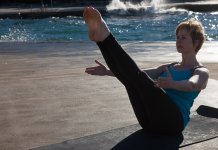Best Core-Strengthening-Exercises: The core muscles help you stand straight or sit without falling. These muscles are present in your belly region, back, pelvis, and glutes.
But with age and muscle disuse, the core muscles may become weak, leading to bad posture and injuries. That’s why it is important to practice 20 minutes of core strengthening exercises every alternate day.
This article lists 5 core strengthening exercises. Read on to know how to do these at home with proper technique. Before we begin, here’s a quick look at the core muscles that we will be targeting through these core strengthening exercises.
What Is The Core?
The Department of Physical Medicine and Rehabilitation, University of Colorado School of Medicine defines the core as “the group of trunk muscles that surround the spine and abdominal viscera. Abdominal, gluteal, hip girdle, paraspinal, and other muscles work in concert to provide spinal stability.”
This means the core includes your belly region, upper back, lower back, hips, sides of the waist, and chest. Here’s the list of all the core muscles:
- Rectus Abdominis – These are the muscles that correspond to the popularly known ‘six-pack’, seen as those squarish parts in the middle. They are located along the front of the abdomen.
- External Abdominal Obliques – These are the muscles seen pointing diagonally downwards from either side. They are located on the sides and front of the abdomen.
- Internal Abdominal Obliques – These muscles are under the external abdominal obliques but point in the opposite direction.
- Transverse Abdominis – These are the deepest muscles, behind the oblique muscles and around the spine.
- Glutes – These are the hip muscles that help in various movements like walking, sitting, and bending.
- Pelvic Floor – These are the muscles that you can feel when you try holding your urine. You will know your pelvic floor muscles are weak if you pass a little urine unintentionally when you cough, sneeze or work out.
- Scapular Muscles – These muscles include the ones present on your upper back and at the back of your shoulders – the trapezius, rhomboid, teres minor and major, pectoralis minor, etc.
Now, you know that to strengthen the core, you must target all the muscles mentioned above. Let’s get started with the exercises.
Top 5 Core Strengthening Exercises:
Before any exercise session, you must warm up. Here’s a 10-minute warm-up session you may follow.
Warm-Up (10 minutes):
- Neck tilts – 1 set of 10 reps
- Head up and down – 1 set of 10 reps
- Neck rotations (do it slowly) – 1 set of 10 reps
- Shoulder rotations – 1 set of 10 reps
- Elbow rotations – 1 set of 10 reps
- Arm rotations – 1 set of 10 reps
- Waist rotations – 1 set of 10 reps
- Spot jogging – 1 min
- Side lunges – 1 set of 10 reps
- Calf raises – 1 set of 10 reps
- Ankle rotations – 1 set of 10 reps
Note: If you have lower back pain, start with the basic core exercise first. Do core activation, core with knee in and out, core with hip knee flexion, and then progress to below exercises that can help you get strong core.
Core Exercises – 20 minutes
1. Flutter Kicks:
Target – Glutes, hip flexors, lower abs, quads, and hamstrings.
How To Do Flutter Kicks?
- Lie down on your back on a mat. Keep your hands by your side, palms flat on the mat, back flat against the mat, and look up at the ceiling.
- Engage your core, lift both your legs off the ground and kick them up and down alternately. Do not let your feet touch the ground before you complete one set.
Sets And Reps – 2 sets of 15 reps
2. Seated Knee Tuck:
Target – Upper, middle, and lower abs, glutes, quads, hamstrings, calves, biceps, and triceps.
How To Do Seated KneeTucks?
- Sit on the mat with your knees flexed and feet flat on the mat. Place your hands behind you, and keep your palms flat on the mat.
- Engage your core, bend your elbows, lean back a bit, and lift your legs in the same flexed knee pose.
- Bring your knees close to your chest, and your upper body close to your knees.
- Lean back and push your legs away. Straighten your legs as you do it.
- Flex your knees and bring them close to your chest, and your upper body close to the knees.
Sets And Reps – 3 sets of 10 reps
3. Crunches:
Target – Rectus abdominis, transverse abdominis, internal and external obliques, and pelvis.
How To Do Crunches?
- Sit on the mat with your knees flexed and feet flat on the mat. Keep your feet together.
- Rollback until the back of your shoulders touches the mat. Do not rest your head on the mat.
- Engage your core and place your fingertips behind the head to support it. Keep your elbows out, arms wide open, and chest out. Do not tuck your chin. This is the starting position.
- Exhale and lift your head (do not push it) so that only the upper back is off the ground. Look at the top of your knees.
- Inhale and slowly go back to the starting position.
Sets And Reps – 2 sets of 15 reps
4. Bicycle Crunch:
Target – Upper, mid, and lower abs, obliques, quads, and hamstrings.
How To Do Bicycle Crunches?
- Lie on the floor, place your hands behind your head, and open your arms. Raise your head and your feet off the floor, flex your knees, and bring them close to your belly.
- Push the right leg back and extend it. Simultaneously, crunch up and try to touch your left knee with your right elbow.
- Fold your right knee. As you do so, push your left leg back and extend it fully. Crunch up and try to touch your right knee with your left elbow.
- This completes one rep.
Sets And Reps – 2 sets of 15 reps
5. Vertical Leg Crunch:
Target – Upper, mid, and lower abs, obliques, quads, hamstrings, rhomboids, lats, and deltoids.
How To Do Vertical Leg Crunches?
- Lie flat on the floor and keep your arms by your side.
- Lift both your legs at 90 degrees from the floor.
- Lift your hands off the floor and try to touch your toes with your fingertips.
- Inhale and go back down.
- Exhale and try to touch your toes with your fingertips.
Sets And Reps – 2 sets of 15 reps
These are the 5 core strengthening exercises that you can do at home at your convenience. Make sure you stretch and cool down after finishing your workout session.
Doing these exercises every other day can help you get the following benefits.
Benefits Of Core Strengthening Exercises:
- Help you get a flat tummy.
- Improve core muscle power.
- Improve muscle coordination.
- Prevent injury.
- Help stabilize the torso.
- Improve respiratory function.
- Improve posture.
- Stabilize the spine, ribs, and pelvis.
Conclusion:
Core exercises are great for improving posture, balance, strength, stamina, and self-confidence. If you are recovering from a stroke or surgery, make sure you have your doctor’s permission to start exercising. If you are doing it for a flat belly, you must also eat healthily and do other cardio workouts and strength training for at least two days a week.
Hope this post was helpful. If you have questions, post them below, and we will get back to you.
FAQs:
Q- Is walking good for core strength?
A- Walking is a good cardio exercise and will help burn calories. However, it is not the ideal workout for strengthening the core.
Q- How can I strengthen my core while sitting?
A- You cannot strengthen your core by sitting. You have to activate your core muscles by doing exercises that target the core muscles.
Q- Does core strengthening help back pain?
A- Yes, correct and supervised core exercises can help reduce back pain. Make sure you talk to your doctor and make your trainer aware of your back pain.
Q- What is the appropriate repetition tempo for core-strength exercises?
A- As a beginner, try 2 sets of 8 reps. Increase it to 3 sets of 8 reps. Later, 3 sets of 12 reps. The sets and reps also depend on the type of exercise you do.





